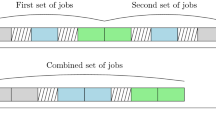Abstract
This study presents a multiobjective scheduling model on parallel machines (MOSP). Compared with other scheduling problems on parallel machines, the MOSP is distinct for the following characteristics: (1) parallel machines are nonidentical, (2) the type of jobs processed on each machine can be restricted, and (3) the multiobjective scheduling problem includes minimizing the maximum completion time among all the machines (makespan) and minimizing the total earliness/tardiness penalty of all the jobs. To solve the MOSP, a new parallel genetic algorithm (PIGA) based on the vector group encoding method and the immune method is proposed. For PIGA, its three distinct characteristics are as follows: Firstly, individuals are represented by a vector group, which can effectively reflect the virtual scheduling policy. Secondly, an immune operator is adopted and studied in order to guarantee diversity of the population. Finally, a local search algorithm is applied to improve the quality of the population. Numerical results show that it is efficient, can better overcome drawbacks of the general genetic algorithm, and has better parallelism.
Similar content being viewed by others
References
Graham RL (1969) Bounds on multiprocessor timing anomalies. SIAM J Appl Math 17:416–429
Garey MR, Johnson DS (1979) Computers and intractability: a guide to the theory of NP completeness. Freeman, San Francisco
Lee CY, Massey JD (1988) Multiprocessor scheduling: combining LPT and MULTIFIT. Discrete Appl Math 20:233–242
Rajendran C (1995) Heuristics for scheduling in flowshop with multiple objectives. Eur J Oper Res 82:540–555
Nagar A, Heragu S, Haddock J (1995) A branch and bound approach for a two-machine flowshop scheduling problem. J Oper Res Soc 46:721–734
Riera J, Alcaide D, Sicilia J (1996) Approximate algorithms for the PCmax problem. Topology 4:345–359
Sridhar J, Rajendran C (1996) Scheduling in flowshop and cellular manufacturing systems with multiple objectives-a genetic algorithmic approach. Prod Plan Control 7:374–382
James RJW (1997) Using tabu search to solve the common due date early/tardy machine scheduling problem. Comput Oper Res 24:199–208
Gupta JND, Ruiz-Torres AJ (2001) A LISTFIT heuristic for minimizing makespan on identical parallel machines. Prod Plan Control 12:28–36
Wang L, Li DW (2002) Genetic algorithm for parallel machine scheduling with due windows. J Sys Eng 17:45–49
de Castro LN, Timmis J (2002) Artificial immune system: a new computational intelligence approach. Springer, New York
Gupta JND, Ho JC, Ruiz-Torres AJ (2004) Makespan minimization on identical parallel machines subject to minimum total flow-time. J Chin Inst Ind Eng 21:220–229
Gao JQ (2005) A parallel hybrid genetic algorithm for solving a kind of non-identical parallel machine scheduling problems. In: Proceedings of the eighth conference on high-performance computing in Asia-Pacific Region, Beijing. IEEE Computer Society, Los Alamitos, pp 469–472
Lee WC, Wu CC, Chen P (2006) A simulated annealing approach to makespan minimization on identical parallel machines. Int J Adv Manuf Technol 31:328–334
Tang LX, Luo JX (2006) A new ILS algorithm for parallel machine scheduling problems. J Intell Manuf 17:609–619
Lin SW, Chou SY, Chen SC (2006) Meta-heuristic approaches for minimizing total earliness and tardiness penalties of single-machine scheduling with a common due date. J Heuristics 13:151–165
Liao CJ, Chen CM Lin CH (2007) Minimizing makespan for two parallel machines with job limit on each availability interval. J Oper Res Soc 58:938–947
Tsai T (2007) A genetic algorithm for solving the single machine earliness/tardiness problem with distinct due dates and ready times. Int J Adv Manuf Technol 31:994–1000
Liao CJ, Chen CM (2007) A variable neighborhood search for minimizing single machine weighted earliness and tardiness with common due date. Comput Ind Eng 52:404–413
Zhang ZC, Zheng L, Weng MX (2007) Dynamic parallel machine scheduling with mean weighted tardiness objective by Q-Learning. Int J Adv Manuf Technol 34:968–980
Cheng TCE, Kang LY, Ng CT (2007) Due-date assignment and parallel-machine scheduling with deteriorating jobs. J Oper Res Soc 58:1103–1108
Author information
Authors and Affiliations
Corresponding author
Rights and permissions
About this article
Cite this article
Gao, J., He, G. & Wang, Y. A new parallel genetic algorithm for solving multiobjective scheduling problems subjected to special process constraint. Int J Adv Manuf Technol 43, 151–160 (2009). https://doi.org/10.1007/s00170-008-1683-2
Received:
Accepted:
Published:
Issue Date:
DOI: https://doi.org/10.1007/s00170-008-1683-2




